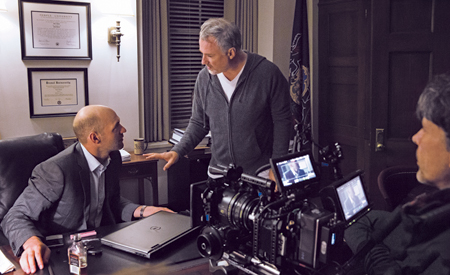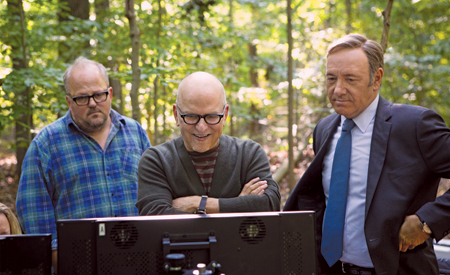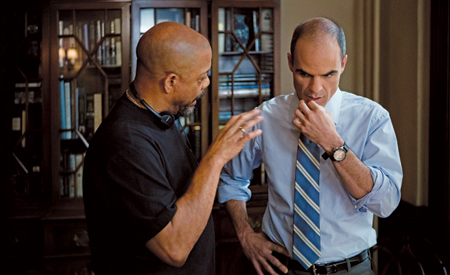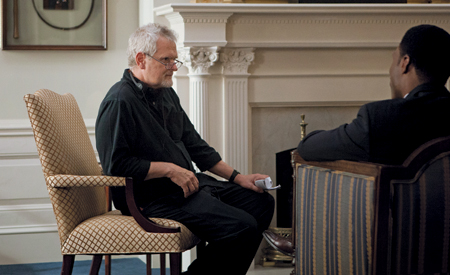By Robert Abele
 PLAYING POLITICS: David Fincher (center) with Corey Stoll, directed two episodes of Netflix's House of Cards including the pilot. (Photo: Patrick Harbron for Netflix)
PLAYING POLITICS: David Fincher (center) with Corey Stoll, directed two episodes of Netflix's House of Cards including the pilot. (Photo: Patrick Harbron for Netflix)
Director David Fincher doesn't mince words when he describes the changing nature of audience behavior regarding small screen episodic storytelling, or, as it has mostly been known, TV-viewing. "The world of 7:30 on Tuesday nights, that's dead," Fincher said during an interview at his offices in Hollywood. "A stake has been driven through its heart, its head has been cut off, and its mouth has been stuffed with garlic. The captive audience is gone. If you give people this opportunity to mainline all in one day, there's reason to believe they will do it."
"This" is House of Cards, an original 13-part series that not only marks the first foray for the DGA Award-nominated director of The Girl With the Dragon Tattoo and The Social Network into [something like] television, it's Netflix's debut as a creator of scripted programming. And by "mainline," Fincher is referring to the fact that if viewers want the binge-watching experience, they'll have that option when Netflix makes the entire House of Cards first season instantly available on its website in February. "It was an option from the beginning," says Fincher. "Eventually [Netflix] came to say, 'We're looking at the data of how we screen stuff, and we believe the world is prepared for this idea that you can have it all [at once].'”
 Alan Coulter (center) reviews a shot with series star Kevin Spacey and DP Tim Ives.
Alan Coulter (center) reviews a shot with series star Kevin Spacey and DP Tim Ives.
What viewers will also get is a series uncommon as a creative enterprise, in that it marries the production efficiency of multiple-episode television with the directorial control typically associated with moviemaking. Working off a two-season, 26-episode commitment from Netflix, Fincher looked to implement a creative process that was liberating for directors. After directing the first two episodes himself, he handed the reins to a succession of five established talents-- James Foley (At Close Range, Glengarry Glen Ross), Joel Schumacher (Phone Booth, A Time to Kill), Charles McDougall (Desperate Housewives, The Office), Carl Franklin (One False Move, Devil in a Blue Dress) and Allen Coulter (The Sopranos, Boardwalk Empire) and told them they could steer their assigned episodes as they saw fit. Directors were able to cast their own day players and people who were introduced in their episodes. As executive producer, Fincher would be there as a sounding board. But unlike most television programs, which are set up to give writers, producers and executives final word, House of Cards was going to be a director-centric playground, filming on several massive sets in a 150,000-square-foot Baltimore warehouse. "I felt like we were telling 13 stories that are all part of one big story, and I was handing off movements to people whose work I admire," says Fincher.
An American reworking of the 1990 British miniseries of the same name about power plays in Parliament, it stars Kevin Spacey as Francis Underwood, a deviously intelligent House of Representatives Majority Whip who will do anything to secure his own political standing, but also punish anyone who stunts his rise. A mixture of backdoor deals, underhanded arrangements and upfront nastiness, House of Cards aims to bend the political drama idealism of The West Wing over its lap and spank it.
For McDougall, whose television experience is extensive, House of Cards was a welcome shake-up. "It didn't have the culture of broadcast TV or even cable networks, it didn't have that involvement through the whole process," says McDougall, who directed episodes seven and eight. "There were no script notes, no involvement on set, and no notes during edits, which made it unique. It's a great privilege to be working on material you know to be good, and to try to do it in a way you feel it should be done. David was forthright about that from the beginning.”
It is uncertain whether any of the pay-cable channels Fincher and his producing partners Joshua Donen and Eric Roth initially went to would have been able to abide Fincher's vision of unimpeded directorial authority. But when Netflix said yes, the understanding was that the directors would be left alone. "Netflix has been incredibly respectful," says Fincher. "They've actively looked for ways to put themselves in business with people [with whom] they could say, 'Go make the thing we just talked about.' It's how the movie business was described to me in the early 70s at Warner Bros. If you could come in and tell your story, and a reasonable number [to make] it, you'd go do it."
Fincher professes to have entered the world of episodic storytelling with no knowledge of how television operates, only a desire to treat directors the way he'd want to be treated as a guest on a series. "I'm way too much of a director advocate," he says. "This isn't TV, because we don't have the studio, we don't have standards and practices, we don't have people breathing down your neck saying, 'Remember, kids love bright colors!' We don't have people militating against collective disinterest. I wanted to create an environment where you go in, point at the left field wall and swing as hard as you can."
Directors were each handed two sequential episodes with 20 days to shoot them. Foley, who was assigned the third and fourth installments, was also given the ninth episode (since the run called for 13 episodes). Block shooting was also employed, which made one of the more important jobs for each director to keep actors and crew aware of the order of events. "It almost felt like shooting an independent feature," says Carl Franklin, who tackled episodes 10 and 11. "With a 20-day shoot, you got a chance to develop a rhythm and get some momentum going, as opposed to starting and stopping and starting again. It gives the actors a chance to get familiar with you."
STATE BUSINESS: Charles McDougall (holding pages), working with Michael Gill, predicts House of Cards will be the first of many made-for-Internet series. (Photo: Patrick Harbron/Netflix)
Each director got to see Fincher's first two episodes as a sort of orientation process, as well as read every script leading up to their own episodes, so it was clear where their stories fit into the overall scheme. Explains Joel Schumacher of his episodes, five and six: "The first four plant a few seeds, but by five and six, shit is hitting the fan. I got some juicy stuff." McDougall says one of his episodes was unusual in that it took place away from Washington and explored a new side of the lead characters typically tightly controlled demeanor. Carl Franklin lets on that he directed some of the season's most emotionally explosive, crescendoing moments, while his handoff in the relay to Coulter brought the series to a close with reactive episodes that "set the table for the next season."
A team was put in place to help ensure continuity as each director hopped on the moving train of a March-to-November shoot. 1st ADs H.H. Cooper and Frank Ferro alternated each two-episode stint, while DP Eigil Bryld was on board for nearly the entire run, except for the final two episodes, which featured DP Tim Ives. Coulter, who Fincher knew from their days shooting commercials, says working on House of Cards was far from the "day player" vibe many shows give off toward guest directors. "On shows where I have a long relationship, like Boardwalk Empire, I do feel creative respect, but as most television directors will attest, that is not often the case," says Coulter. "Sometimes one feels it's almost a favor you're being given by the writers and producer, who in many cases can't wait for you to get out of the room so they can do whatever they do. This was unusual in that from the beginning David said directors would have final cut. He'd have his comments, but we'd be able to address those comments."
Fincher acknowledges that he would suggest trims to the directors when he was confused by something but, adds, "I'm always happy to write on my emails, 'This is from me to you, do what you want with this, and know always that I know how to go fuck myself.'"
As for self-imposed parameters in kicking off the series, Fincher describes shooting his own episodes as a study in scaling back his usual movie preparation approach, but not foregoing working methods he knows are well-remarked upon within the industry. "A lot of people had a smile in the corner of their mouths when they said to me, 'Dave, if you think you're going to get 20 takes, you're just not going to make your day.' But I think I averaged somewhere around 35 setups and 14 takes per setup. It's about how you manage your time. Obviously, shooting digitally helps, [House of Cards was shot using the RED camera] because I never had to cut. I could say, 'Go back out and come in again,' and it's amazing the pace you get. It's a Frank Capra trick from way back. Because he could only print so many takes, he used to say, 'Keep it rolling, go out and come in.' What he found was people were more energized, and it gave this effervescence, and I ended up having to do that. But I had three more days [per episode] than the other directors in order to set the tone."
The tone Fincher was after stemmed from a belief that the camera should take a backseat to the performers, which include Robin Wright as Spacey's Lady Macbeth-like wife, Kate Mara as a young, ambitious journalist, and Corey Stoll as a vice-loving congressman. One of the few things Fincher spoke to each director about before they began work was to be respectful of the main actors who were doing the heavy lifting. Another was that handheld shooting and Steadicam usage was frowned upon, which for anyone familiar with Fincher's work--rich in elegant, symmetrical compositions and spare, gliding camerawork-- shouldn't have come as a surprise.
"I remember David saying something like, he would only move the camera if there was a damn good reason to," recalls Foley. "So I found myself with a self-imposed discipline to work within because I felt it should be stylistically consistent."
Schumacher, who has been friends with Fincher for over 25 years, says, "This is very classical, where framing is important. It allows actors to fill the space and play out the scene without cutting a lot. It's the way movies used to be shot. There's plenty of space to dolly and do the voodoo we do, but without handheld or Steadicam, which are sometimes used in lazy filmmaking. We really tried to shoot it like a film."
One visual model bandied about between Fincher and the guest directors was another film about dirty politics. "[David] shot the newspaper office [in House of Cards] very similarly to how it was shot in All the President's Men," says McDougall. "In terms of the low angles, the wide lenses, the lighting style, it's from that era of American filmmaking when such great films were made. It's a very stripped-down [approach] toward design, lighting and performance."
 Carl Franklin (left) with Michael Kelly, says directing House of Cards with a 20-day shoot was like making an independent feature. (Photo: Patrick Harbron/Netflix)
Carl Franklin (left) with Michael Kelly, says directing House of Cards with a 20-day shoot was like making an independent feature. (Photo: Patrick Harbron/Netflix)
Fincher also made sure to remind his fellow directors that they could be minimal in their coverage. A shot of somebody reading a business card, for example, was about believing the actor's face, not having to see an insert of the card. Such guidance gave Carl Franklin the freedom to avoid the emphasis on close-ups that network television requires, and be more subtle with choreography, allowing scenes to play out in carefully orchestrated master shots. "A lot of times television is master shot then bang, bang, bang, just heads. So I was happy to hear that they were not interested in that," Franklin says. "That really allows for you to design interesting shots, shots that have a lot of information communicated in different ways. It's trusting the pacing within the scene and not feeling that you have to manipulate it later with a lot of cuts."
Coulter, long a fan of assembling an episode in his head before filming, recalls his House of Cards editor telling him he'd "white-knuckled it" with footage. Says Coulter, "I asked him, 'Was there too little?' And he said, 'No, but there was just enough. There will be nothing lying on the cutting room floor when we're done.' I'm not a big promoter of shooting a bunch of footage and leaving it on the doorstep of the producer. I'm far more interested in shooting those pieces that I need to tell the story."
What was most interesting for Fincher as an executive producer was his access to other director's dailies. It was an eye-opening experience in how other filmmakers operate. "There were times I'd say, 'That's so interesting. That doesn't seem like where the drama is,' and then you watch a scene get honed and cut and then you say, 'That's somebody's instinct.' I watched Jamie [Foley], and he's like a pit bull. He follows the drama. It's not an imposed thing. It has to present itself. He's going to shoot through the gristle and get to the thing, and that's so different than my style, which is much more pre-vivisection and going in, saying, 'You're doing this, and you're doing this and I'm not interested in that moment because it doesn't fit into my overall scheme.' Jamie is much more full contact. He'd say [to the actors] 'No, tell me your thing.'"
Schumacher, notes Fincher, is "very much about the proscenium and axis angle. You'd watch the dailies and think, 'It's so economical.' He knows how to make things beautiful, and he's great with actors. After Jamie and me, I think everybody was really exhausted, and then Joel comes in and suddenly everybody's having a great time again."
One of the more wickedly fun elements of House of Cards are Spacey's addresses to the camera: fourth-wall-busting moments in which his character parses a situation for its underlying meaning, or witheringly delivers a trenchantly cynical (and usually funny) aphorism about politics. Sometimes, the aside is merely a knowing glance to the viewer, acknowledging that a gambit is in play. "You're there with Machiavelli as he plans his chess moves," says Schumacher of the device, a key ingredient from the original British miniseries. "For instance, Kevin's character could be in a conference room with a lot of people rattling on, someone may say something, and then he'll turn to the camera. But that camera is only there for that specific reason. It doesn't include anyone else, or if it does, they're out of focus."
Of course, when you have an actor of Spacey's caliber, says McDougall, such moments just naturally sing. "The glance to the camera is something that became increasingly cheeky as the series went on," he adds. "It's enormously enjoyable to watch because [Spacey] is a master of that interaction with the lens. When you've got people like Spacey and Robin Wright, their instincts are always in the right place."
Fincher says Spacey was everyone's "first and only" choice when the project was hatched. He admits it might have been foolhardy to begin developing the pilot script with writer Beau Willimon with only Spacey in mind. "Imagine if you don't get him, you are well and truly screwed," Fincher remarks. But the actor quickly committed upon seeing the material. The same fortune happened with the key players. "I said to the cast at the first read-through, 'The good news and the bad news is everybody here is our first choice, so expectations are high.'"
What surprised Fincher about the production process on an episodic series, however, was the opportunity to recognize a day player's worth and let it alter the storytelling in future episodes; something that isn't readily available in the world of moviemaking.
NO FRILLS: (above) Joel Schumacher (left) with DP Eigil Bryld, says the series was made in a classical style where the framing of shots was very important. (below) James Foley, who had taken many years off from feature directing, said the freedom of the series "reawakened his sense of discovery." (Photos: Patrick Harbron/Netflix)

"There is a prostitute character, and we cast the actor on the basis of three lines,” says Fincher. “She started out as an extra in the first [episode], and now she’s in something like eight. Beau, to his credit, said ‘I think there’s more to be mined here.’ These are people you haven’t screen-tested time and time again, so you don’t know what they’re capable of, and then they surprise you. That was really interesting. I wish you could, over a hundred days of shooting a movie, be flexible enough to say, ‘Let’s jettison all this and move in this direction.’” Ultimately what Fincher wanted directors to feel as they joined House of Cards was a “sink or swim” mentality born out of invested participation; that a belief in the project would be a motivator to take their episodes and make the most of them as directors.
“When I did television commercials, I never thought, ‘Oh screw it, it’s only two days out of my life.’ You’ve got to want to be there. I didn’t want people feeling like they were slumming. The actors gave a year of their lives and moved to Baltimore because they believed in what we were selling, so you’ve got to believe in it, too. And if we have the opportunity to create a place for more storytelling to be made, that seems to be what we should be doing.” Looking back on his experience, McDougall sees a business model for investment, focus on quality and same-day distribution that thrillingly flies in the face of so many “illogical” processes ingrained in regular television. He adds, “My guess is House of Cards will be the first of many productions like this.”
For Foley, who had taken many years off from feature directing, the freedom-within-limitations exercise was the ideal re-engagement project. “I feel like my directorial brain expanded from doing this process. It has reawakened my sense of discovery.”